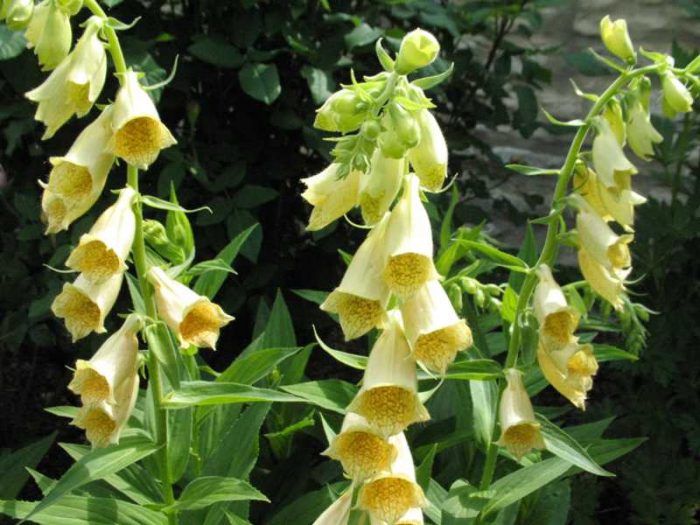The foxglove herb, also called digitalis, is a member of the Plantain family, but it used to be part of the Scarlet family. The scientific name digatilis originated from the Latin word translated as "thimble". This genus includes about 35 species. In nature, such a plant is widespread in the Mediterranean, but it can also be found in other regions of Europe, in North Africa and Western Asia. 4 types of digitalis grow in the Caucasus, and 2 types - in the European part of Russia and in Western Siberia. The foxglove prefers to grow on forest edges and clearings, among bushes and in meadows.
Content
Features of digitalis
The foxglove is a herbaceous biennial or perennial plant, while in the Western Mediterranean you can find digitalis in the form of a semi-shrub or shrub. The shoots are unbranched and rigid, their height varies from 0.3 to 1.5 m. Large greenish leaf plates have a lanceolate and oblong shape, they are alternately sharp, gradually turning into bracts. Bilateral or one-sided apical racemose inflorescences consist of large irregularly shaped flowers, painted in light red, yellow or purple. Bell-shaped flowers have a special device, when a fly, bumblebee, bee or wasp is taken into them, then pollen falls on it, then such an insect moves to another flower, carrying pollen on itself. This is how pollination works. This plant blooms in June, and fades - in the first autumn weeks. The fruit is a capsule, inside of which there are many small brown seeds, they remain viable for 2-3 years. One bush can produce about 2 million seeds. Any kind and variety of foxglove is poisonous, therefore it is forbidden to plant them on the flower beds of children's institutions.Certain types of digitalis are grown as ornamental plants, while others are better known as medicinal plants. The foliage of most species contains glycosides, and it is they that are used in alternative and traditional medicine. Such a plant is resistant to frost and drought, as well as undemanding to the care and composition of the soil.
Growing digitalis from seeds
Sowing
Seedlings are sown in the second half of March. The seeds need to be pre-soaked, for this they need to be filled with water, which should be replaced every six hours. Duration of soaking is 7 days. The prepared seeds should be spread over the surface of the substrate, then they are covered with a thin layer of sand. The container must be covered with foil or glass and removed to a warm place, where the consecration should be soft and diffused. Seedlings may appear half a month after sowing.
Growing seedlings
Seedling development is very slow at first. When the formation of the first true leaf plates is over, the plant must be picked. They can be planted in individual cups or in a container that is larger and more voluminous than the previous one, keeping a distance of 7-10 centimeters between the seedlings. It is quite easy to care for such seedlings. It is necessary to water it as the soil mixture dries, regularly gently loosen the surface of the substrate, protect it from drafts and from direct sunlight.
When 15 days remain before the foxglove is planted in open soil, you should start hardening procedures, they will help the seedlings adapt to unusual conditions in the garden. To do this, the seedlings are taken out every day to the balcony or to the street, while the duration of this procedure should be increased gradually. Planting plants in open ground can be carried out after they can be outdoors for days.


Watch this video on YouTube
Planting digitalis in open ground
What time to plant
Planting digitalis seedlings into open soil is carried out after there is no threat of return frosts in spring (from the last days of May to the first days of June). When the time for planting comes, 5 or 6 true leaf plates should already form on the seedlings, and the soil should warm up very well.
It is best to choose a planting site that is open and well-lit, but these flowers can also be grown in light shade. The area under deciduous plants is not suitable for planting digitalis, because moisture retention is observed in the soil of the near-stem circle, because of this, the digitalis may get wet or it will not bloom. Foliage flying around in autumn from trees is also undesirable for such a plant.
How to plant foxglove
The soil on the site should be nutritious, loose and permeable (no stagnation of moisture should be observed). The site for planting should be prepared in advance, for this they dig to the depth of the bayonet of the shovel, while humus or compost should be added to the soil (for 1 square meter of the site from 4 to 5 kilograms). During planting, a distance of 0.15-0.2 m must be observed between the bushes, and the distance between the rows should be from 0.25 to 0.3 m. In the prepared area, holes must first be made, the size of which should slightly exceed the size of the root system seedlings. Then the plants from the cups should be carefully transferred into the holes, while trying not to destroy the earthen lump. Seedlings from the container must be taken out very carefully along with the soil and placed in the holes. When the foxglove is planted, the surface of the soil must be tamped down, and the plant must be watered well. In the first year after planting, a leaf rosette is formed in such a plant. For the first time it will bloom only next season.


Watch this video on YouTube
Foxglove care
Growing foxglove in the garden is the same as many garden plants. Such a flower needs systematic weeding and loosening of the surface of the site, it also needs to be watered in a timely manner, fed and treated from pests and diseases as needed.
Watering such flowers is necessary only in a sufficiently long dry period. If it rains regularly in the summer, then such a plant will do without watering at all. When it rains or the plant is watered, it is necessary to very carefully loosen the surface of the site to a shallow depth. The digitalis root system is horizontal and is very close to the surface of the site, so it is very easy to injure it during loosening.
Throughout the growing season, such a flower needs to be fed only 1 or 2 times, using a complex mineral fertilizer in liquid form (a solution of minerals must be mixed with water for irrigation). In order for the flowering to be longer, and the bushes to retain their spectacular appearance until the very fall, it is necessary to promptly cut off fading flowers and inflorescences.
Transfer
Transplanting digitalis to a new place is not difficult at all, because its root system is horizontal and it is quite easy to remove it from the soil. The dug out bush must be placed in a previously prepared hole, while its size should slightly exceed the size of the root system of the plant, taken together with a lump of earth. Transplanted bushes need watering.
Diseases and pests
Digitalis most often suffers from spotting, viral mosaics, rot or powdery mildew. If the bush is very strongly affected by spotting or powdery mildew, then it is recommended to remove it from the soil and destroy, while the remaining plants must be sprayed with a solution of a fungicidal preparation. It should be remembered that viral diseases (for example, mosaic), rotting of peduncles and root rot cannot be treated, in this regard, infected bushes must be removed from the soil and destroyed.
Various types of aphids can settle on foxgloves. To get rid of such pests, plants must be sprayed with Antitlin, Biotlin and Iskra. Remember that a sucking insect like aphids is considered the main carrier of dangerous viral diseases, therefore, the fight against this pest begins at the first signs of damage to the plant.
Perennial foxglove after flowering
Since the root system of such a flower is located very close to the soil surface, in some cases it is exposed. In this regard, in the autumn, the plant root system should be sprinkled with fertile soil so that the plant does not suffer during wintering.
Perennial species and varieties are characterized by a fairly high frost resistance, however, if there is little snow in the winter, such a flower may freeze out. When the peduncles turn yellow and fade, they must be cut off, while the outlet must be covered with sawdust, dried foliage or spruce branches. While the bushes are young, they must be covered for the winter.
Foxglove breeding
Digitalis can be propagated by seeds (non-seedling and seedling), as well as by basal processes.
How to grow from seeds
How to grow foxglove through seedlings is described in detail above. However, experienced gardeners prefer to sow seeds directly in open soil. It is necessary to sow in spring in the last decade of April or in the first days of May. Before sowing, the seeds are prepared in the same way as when growing digitalis through seedlings. Seeds should be placed on the surface of the site, keeping a distance of 15–20 centimeters between them. It is not necessary to deepen the seeds, they are sprinkled with a thin layer of soil.If the spring is cool enough, then it is recommended to cover the crops with lutrasil. Excessively dense seedlings must be thinned out, in this case the outlets will be larger. This plant reproduces well by self-seeding.
Digitalis propagation by shoots
Digitalis can also be propagated vegetatively by basal processes. To do this, cut off the brushes that have begun to fade from all the peduncles, while leaving only the densest inflorescences for collecting seeds. About 20 days later, a few basal tines should grow at the base of the trimmed peduncles. After 7 or 8 leaf plates grow on each of the root rosettes, they must be carefully separated and transplanted to a new place. Such shoots will take root before the onset of the autumn period, and they will not be afraid of the coming winter. In the next season, such a plant will grow flower stalks, and it will bloom.
Types and varieties of foxglove with photos and names
Below will be described those types and varieties of digitalis that are cultivated by gardeners most often.
Purple foxglove (Digitalis purpurea)
The homeland of this species is Southern, Central and Western Europe. This perennial plant is often cultivated as a biennial. Its height is about one and a half meters. On the surface of low-branched erect shoots, there is dense pubescence, there is a rosette consisting of basal leaf plates. The upper leaf plates are rounded-elongated, crenate along the edge are sessile, their front surface is velvety, and on the back there is a tomentose pubescence. Alternate stem leaf plates have long winged petioles. The racemose one-sided inflorescence reaches 0.8 m in length, it consists of flowers of five centimeters in length, which can be painted in carmine, cream, white, pink or purple, there is a dark smear inside the corolla, and short hairs are on its surface. Flowering is observed throughout the summer. It has been cultivated since ancient times.
There are several varieties, namely spotted, large-flowered and gloxiniform. Of the greatest interest of all digitalis gloxiniform hybrids is the Shirley variety: the height of the bush is about 150 cm, flowering is long, one-sided inflorescences consist of drooping, open spotted flowers, which are painted purple, pink or cream inside. The Excelsior hybrid mix is also quite popular: the peduncles reach a height of about 1.8 m, very large flowers are placed on them in a spiral. The Peloric mix is also quite popular: the height of the peduncles is about 1.8 m, it is covered with large flowers. The one-color selective variety of this type, called Rosy Champagne, reaches a height of about 1.2 m and has a rather spectacular appearance.
Large-flowered digitalis (Digitalis grandiflora = Digitalis ambigua)
Under natural conditions, this species can be found in Western Europe, the European part of Russia, Ukraine, the Mediterranean and in South-Western Siberia. The height of such digitalis is not more than 1.2 m. The oblong-lanceolate leaf plates have pubescence, located along the edge and along the veins. Drooping racemose inflorescences consist of flowers of six centimeters in length, painted yellow, inside the corolla there are brown veins. The outer surface of the flowers is covered with light pubescence. Cultivated since 1561.
Rusty foxglove (Digitalis ferruginea)
This species is one of the most beautiful. The height of the bush can vary from 0.7 to 1.2 m, however, there are specimens of two meters in height. Slightly pubescent or bare leaf plates have an oblong-lanceolate shape. The flowers, four centimeters long, have a shape similar to an orchid, while the lower lip is very pronounced.Flowers can be painted in a variety of color shades: from yellow-gray, turning into cinnamon-golden or rusty, to yellowish with a pink bloom. The inner surface of the corolla is covered with veins of brown-red or lilac color. The flowers are part of large racemose inflorescences. Flowering is observed from mid-June to August. Cultivated since 1597.
Woolly foxglove (Digitalis lanata)
This type is the most ordinary-looking. In the wild, found in Moldova. This plant is medicinal and has undoubted advantages. On a single peduncle, small flowers of a yellow-brown color with purple veins bloom. Dense pubescence covers the axis of the inflorescence, the name of this species is associated with this particular feature. The plant blooms in July. Flowering time is approximately 6 weeks.
Yellow foxglove (Digitalis lutea)
In nature, this species is found in the southwestern part of Europe. The height of the bush is 0.8–1 m. There is no pubescence on the shoots and oblong-oval leaf plates. Length of yellow flowers about 25 mm. Flowering begins in July. It has been cultivated since 1597. The most popular variety is Gelb Janus: the flowers are yellowish.
Another cultivated foxglove is dark, or indistinct, Tapsi, Merton, Nevada, ciliate and some other hybrid forms and species.
Foxglove properties: harm and benefit
The healing properties of digitalis
Since ancient times, digitalis has been used by healers for the treatment of chest and abdominal dropsy, epilepsy, with the help of it they eliminated pain in skin diseases, and it was also used to cleanse the body and for constipation. But if the dosage was calculated incorrectly, then the person had diarrhea and vomiting, and very often deaths were observed. In this regard, for a century, everyone has forgotten about this plant.
Since the 18th century, digitalis has been used in traditional medicine. At this time, extremely unusual properties were found in him. Leaf plates collected in the first year are the main medicinal raw material. They include 62 glycosides, for example: gitoxin and digitoxin, lanatosides A, B, C, D, E, etc. These biologically active substances are widely used in the fight against a large number of cardiovascular diseases.
Digitalis is used to:
- make the vascular walls stronger;
- improve blood supply to tissues and muscles;
- normalize hemodynamics;
- get rid of cardiosclerosis;
- get rid of tachycardia, hypertension, myocardial dystrophy, mitral defects;
- get rid of atrial fibrillation.
Often it is woolly digitalis that is used to obtain medicinal raw materials. Organic acids, cardiotonic and steroidal glycosides are extracted from such a plant. Much less nutrients are found in digitalis ciliated, purple and rusty, but they are still used in traditional medicine. The foliage is used to make the powder found in tablets and suppositories. In alternative medicine, an infusion from this plant is used.


Watch this video on YouTube
Contraindications
Absolutely all types of digitalis in their composition contain poisons dangerous to humans, therefore, self-medication with this plant should be completely excluded. Means made on the basis of digitalis cannot be taken by people with sick lungs, angina pectoris, pericarditis, myocarditis, myocardial infarction, gastric tachycardia, as well as children and pregnant women. If poisoning occurs, vomiting, skin rashes, respiratory failure, nausea, severe pain in the abdomen, cramps, heart failure will appear. If at least one of these symptoms appears, an ambulance should be called urgently. If you use funds made on the basis of digitalis for a long time, then toxic substances will accumulate in the body, which will cause the development of anorexia, loss of appetite and hallucinations.
























